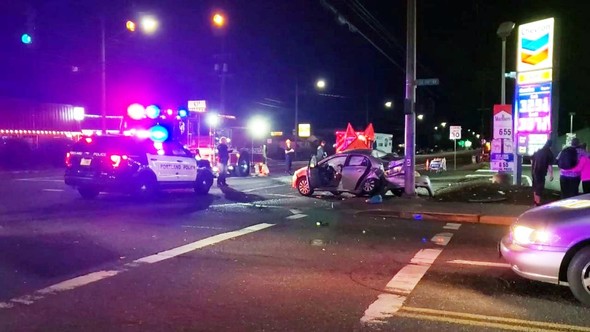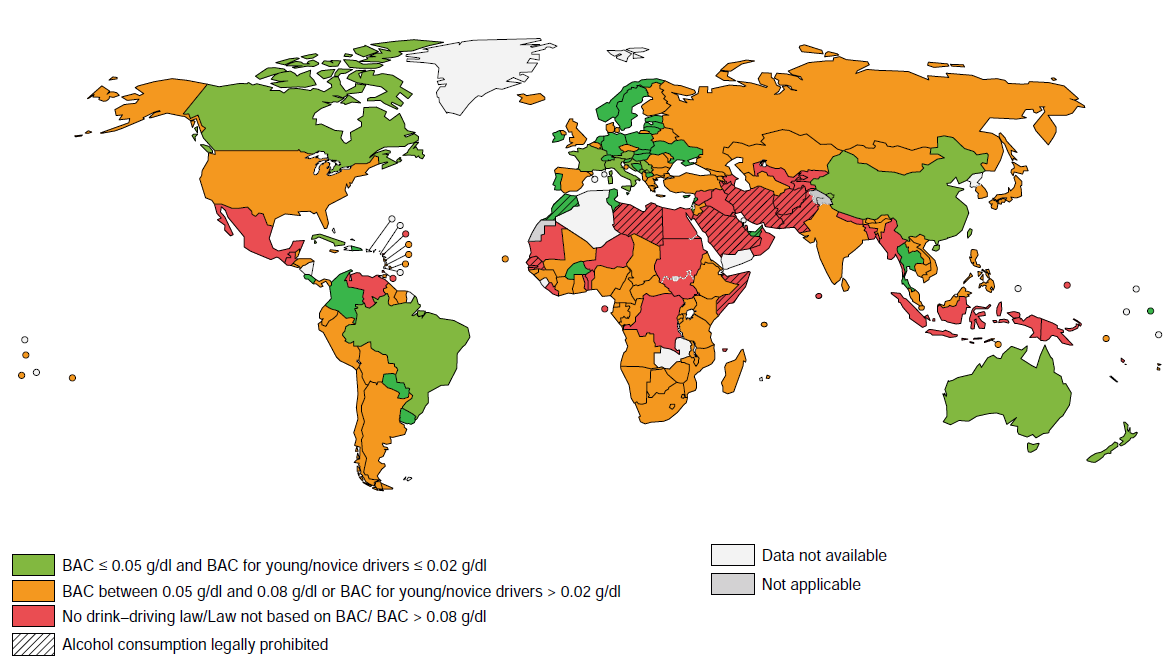 News media contact:
Dylan Rivera
(503) 577-7534
dylan.rivera@portlandoregon.gov
PBOT News Blog:
Alcohol remains a top factor in deadly Portland crashes
If you drink, it is safest to avoid driving and to help others do the same
 A deadly crash on August 12, 2019, at SE Division Street & 112th Avenue. Image: KPTV Fox 12 Oregon.
(Nov. 27, 2019) In Portland we are rightly proud of our local breweries, wineries, and distilleries.
But we should not be proud of continued serious crashes involving alcohol. Nearly half of Portland traffic deaths from 2013 through 2017 involved alcohol impairment (see chart). An additional 192 people suffered serious injuries, such as brain damage or paralysis, as a result of alcohol-involved crashes during the same period.
The proportion of deadly Portland crashes involving alcohol is consistently high. Data: Oregon Department of Transportation.
In the 12 months through September, at least 10 people died in Portland crashes in which the Portland Police Bureau believe alcohol may have been a factor.
This includes the death of 64-year-old Darnell Jolly, who was in a crosswalk at SE Stark & 146th Avenue when he was hit by a 64-year-old driver impaired by alcohol on Friday, Oct. 26, 2018, around 10:30 p.m.
Other recent cases include:
- On Saturday, March 19, 2016, around 3:45 p.m., a 55-year-old driver impaired by alcohol made a left turn from SE Center Street into his driveway into the path of a person on a bicycle, resulting in the death of 17-year-old Austin Joe Hrynko.
- Also on March 19, 2016, around 11 p.m., a 29-year-old driver impaired by alcohol hit a person walking across NE Cully Boulevard near Mason Street, resulting in the death of 58-year-old Patrick Curry Sr.
- On Wednesday, June 28, 2017, around 10:45 p.m., a 29-year-old driver impaired by alcohol made a left turn on N Columbia Boulevard into the path of a second vehicle, resulting in the death of 22-year-old Brandon Levison and 23-year-old Donell Lee Wilkins, who were passengers in the second vehicle
Drinking alcohol and then driving sharply increases the risk of killing or seriously injuring yourself or others. Odds of crashing double even below Oregon’s legal blood alcohol content (BAC) limit of 0.08. (People below 0.08 can still face DUII charges if they fail field sobriety tests.)
People not hurt in a crash may still face license suspension, job loss, higher insurance costs, court fees, or jail time. Crash survivors may also face depression or other mental health issues.
While substances other than alcohol can also increase the risk of crashing, research indicates that alcohol has the biggest impact on deadly crash risk.
How many drinks are safe before driving?
It is best to avoid driving after drinking alcohol. Even one drink can make it harder for people to visually track moving targets and to perform two tasks at the same time, both of which are important for driving. By the time a person hits Oregon’s legal BAC limit they are three times more likely to crash compared to a sober person.
Translating a specific number of drinks into BAC levels is difficult. BAC for a given number of drinks depends on factors including height, weight, gender, a person’s liver function, and the strength of the drinks.
The effects of even low levels of alcohol on driving have led Utah and many countries to adopt BAC limits lower than 0.08. Countries including Brazil have made it illegal to have any measurable alcohol in the blood of people driving (see map). The World Health Organization recommends legal limits no higher than 0.05 for the general population and no higher than 0.02 for “young and novice” drivers. A bill to lower Oregon’s legal BAC limit did not pass in the latest legislative session.
 Countries meeting World Health Organization ”best practice” for drinking and driving (green color). Graphic courtesy World Health Organization.
How you can help
-
Do your best to avoid driving after drinking alcohol. Public transit, taxis, and ridehailing services are good alternatives to driving. If you are drinking around a holiday or big event, check for ridehailing and taxi discounts through PBOT’s Safe Ride Home program.
-
If you are drinking with a group, help others travel in ways other than driving themselves. Intervening to prevent others from driving after drinking can be a powerful way to prevent serious crashes.
-
Overnight parking is allowed at most public SmartPark garages and on many Portland streets. A parking ticket is also much cheaper than a crash.
-
Parents and guardians can help their children make safe choices by teaching them not to drink and drive or to ride with anyone who has been drinking.
Thank you for helping Portland meet our Vision Zero goal to eliminate traffic deaths and serious injuries.
Learn more about how we are supporting safe streets at visionzeroportland.com
Data sources: The Oregon Department of Transportation maintains the official crash record for all crashes in Oregon. ODOT currently provides crash data through 2017. More recent data is available through the Portland Police Bureau; this data is considered preliminary until processed by ODOT. Learn more about crash data.
The Portland Bureau of Transportation (PBOT) is the steward of the City’s transportation system, and a community partner in shaping a livable city. We plan, build, manage and maintain an effective and safe transportation system that provides access and mobility. www.portlandoregon.gov/transportation
|